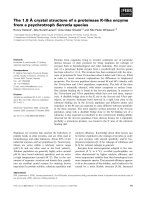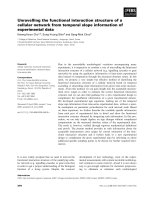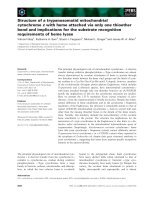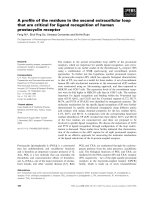Chapter 2Communicating Over the Network Quangkien@gmail.com.OverviewDescribe the structure of a network, including the devices and media that are necessary for successful communications. Explain the function of protocols in network communications. Ex potx
Bạn đang xem bản rút gọn của tài liệu. Xem và tải ngay bản đầy đủ của tài liệu tại đây (3.01 MB, 52 trang )
Chapter 2
Communicating Over the Network
Overview
Describe the structure of a network, including the
devices and media that are necessary for successful
communications.
Explain the function of protocols in network
communications.
Explain the advantages of using a layered model to
2
Explain the advantages of using a layered model to
describe network functionality.
Describe the role of each layer in two recognized
network models: The TCP/IP model and the OSI model.
Describe the importance of addressing and naming
schemes in network communications.
The Platform for Communications
Elements of Communication
4
Communicating the Messages
00101010100101010101010101010101010
I have to wait…
Continuous stream of bits
5
Single communications (e.g. video, e-mail message) could be:
Continuous stream of bits
Take over (hog) the network.
Significant delays
Inefficient use
Any loss - resend entire message
I have to wait…
Communicating the Messages
Segmentation
001010
001010
001010
001010
001010
001010
6
Better approach – segmentation.
Multiplexing:
Different conversations can be interleaved.
Communicating the Messages
X
7
Benefits
Reliability (3)
Different paths
Alternate path
Only the missing segments need to be retransmitted
Disadvantage
of
Segmentation
8
Disadvantage – added level of complexity.
Analogy: 100 page letter one page at a time
Separate envelopes
Sequencing
Components of the Network
9
Devices (hardware)
End devices, switch, router, firewall, hub
Media (wired, wireless)
Cables, wireless mediums
Services (software)
Network applications, routing protocols, processes, algorithms
End devices
10
End devices or hosts:
The source or destination of a message.
Source Address: 209.67.102.55
Destination Address: 107.16.4.21
209.67.102.55 107.16.4.21
11
Each host is identified by an address.
IP (Internet Protocol) address (later)
Servers and Clients
Server
Client
12
A host
Client, Server, or both.
Software determines the role.
Servers provide information and services to clients
e-mail or web pages
Clients request information from the server.
Server
Intermediary
Devices
Intermediary devices
:
routers
switch
or hub
switch
or hub
13
Intermediary devices
:
Connectivity to and between networks
Examples (4):
Network Access Devices (Hubs, switches, and wireless access points)
Internetworking Devices (routers)
Communication Servers and Modems
Security Devices (firewalls)
Intermediary Devices and their Role on the Network
Intermediary devices to provide connectivity and to work behind the
scenes to ensure that data flows across the network.
These devices connect the individual hosts to the network and can
connect multiple individual networks to form an internetwork.
Examples of intermediary network devices are:
14
Examples of intermediary network devices are:
– Network Access Devices (Hubs, switches, and wireless access
points).
– Internetworking Devices (routers).
– Communication Servers and Modems.
– Security Devices (firewalls)
Intermediary Devices and their Role on the Network
Processes running on the intermediary network devices perform
these functions:
– Regenerate and retransmit data signals.
– Maintain information about what pathways exist through the network
and internetwork.
15
and internetwork.
– Notify other devices of errors and communication failures.
– Direct data along alternate pathways when there is a link failure.
– Classify and direct messages according to QoS priorities.
– Permit or deny the flow of data, based on security settings
Network
Media
16
Communication across a network is carried on a medium. The medium
provides the channel over which the message travels from source to
destination
Network media: The medium over which the message travels.
Metallic wires - electrical impulses.
Fiber optics – pulses of light
Wireless – electromagnetic waves.
Network
Media
17
Different types of network media have different features and benefits.
Criteria for choosing a network media are:
– The distance the media can successfully carry a signal.
– The environment in which the media is to be installed.
– The amount of data and the speed at which it must be transmitted.
– The cost of the media and installation.
Local Area Network (LAN)
18
Local Area Network (LAN)
An individual network usually spans a single geographical area, providing
services and applications to people within a common organizational
structure, such as a single business, campus or region.
Wide Area Network (WAN)
Wide Area Networks (WANs)
T1, DS3, OC3
PPP, HDLC
Frame Relay, ATM
ISDN, POTS
19
Wide Area Networks (WANs)
Leased connections through a telecommunications service provider
network.
Networks that connect LANs in geographically separated locations
Telecommunications service provider (TSP) interconnect the LANs at the
different locations.
Voice and data on separate networks or converged networks
The Internet –
A Network of
Networks
20
ISPs (Internet Service Providers)
Often also TSPs
Connect their customers to the Internet.
The Internet – ISPs connected to other ISPs
The Internet – A Network of Networks
•Although there are benefits to using a LAN or
WAN, most of us need to communicate with a
resource on another network, outside of our local
organization.
• Examples of this type of communication include:
–
Sending an e
-
mail to a friend in another country
21
–
Sending an e
-
mail to a friend in another country
– Accessing news or products on a website
– Getting files from a neighbor's computer
– Instant messaging with a relative in another city
– Following a favorite sporting team's performance
on a cell phone
Network
Representations
22
Network Interface Card (NIC)
Ports and interfaces (used interchangeably)
Physical Port ( connector or outlet)
Interface - Connect to individual networks.
Protocols
Protocol
A protocol stack shows how the individual protocols
within the suite are implemented on the host. The
protocols are viewed as a layered hierarchy, with each
higher level services depending on the functionality
defined by the protocols shown in the lower levels.
24
Protocol – Rules that govern communications.
Protocol suite - A group of inter-related protocols
Example: TCP/IP
A protocol stack (sometimes communications stack) is a particular software implementation of a
computer networking protocol suite. The terms are often used interchangeably. Strictly speaking, the suite is the
definition of the protocols, and the stack is the software implementation of them.
Network Protocols
At the human level, some communication rules are formal and others
are simply understood, or implicit, based on custom and practice. For
devices to successfully communicate, a network protocol suite must
describe precise requirements and interactions
Networking protocols suites describe processes such as:
25
Networking protocols suites describe processes such as:
– The format or structure of the message.
– The process by which networking devices share information about.
pathways with other networks.
– How and when error and system messages are passed between
devices.
– The setup and termination of data transfer sessions.









